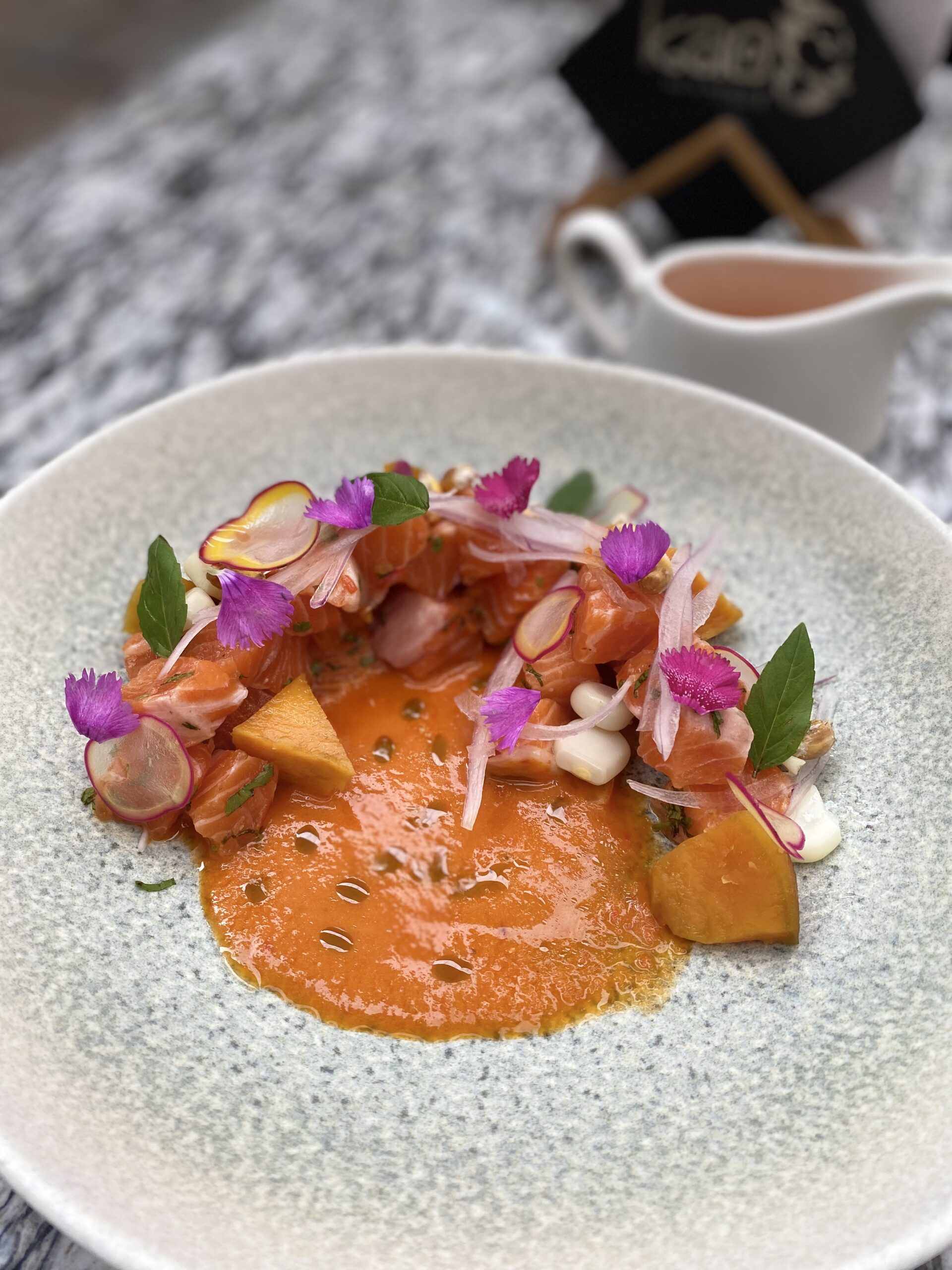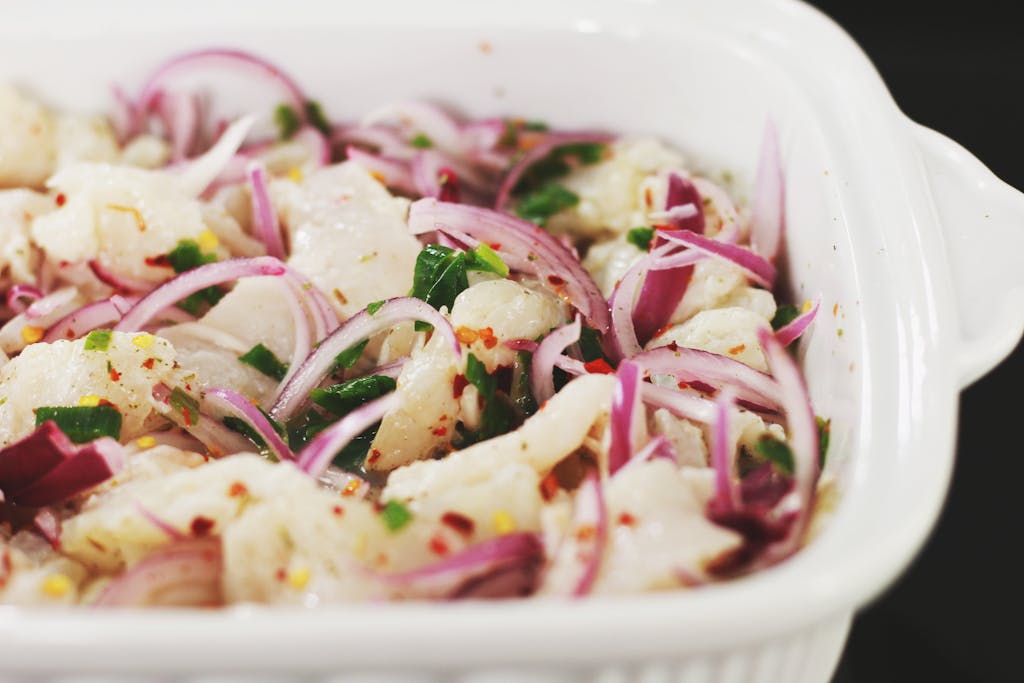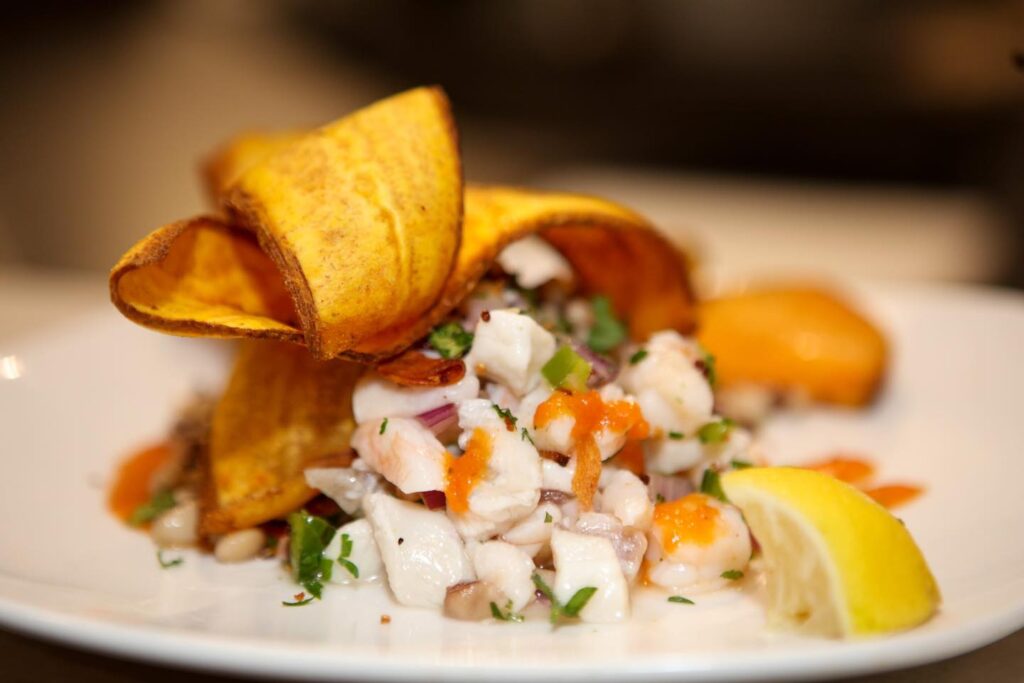Global Flavors: Authentic Peruvian Ceviche Recipe
April 9, 2024
Whenever I crave the taste of Peruvian Ceviche, my mind drifts to memories of my travels in Peru. During my South American travels, I had the pleasure of experiencing the culinary scenes of Lima, where I discovered the magic of this beloved dish – Ceviche. But the Peruvian way.
Ceviche became a cherished part of my travels during my time in Peru. Whether I was strolling along Mancora’s coastline or exploring Miraflores’ markets, there was always an opportunity to savor this refreshing dish. It wasn’t long before it claimed the title of my favorite meal, offering a perfect blend of flavors that captured the essence of Peruvian cuisine.
My journey to embracing the art of Peruvian ceviche began with my first taste of it in a local eatery in Mancora. I was hooked when the tangy citrus-infused marinade met my taste buds. Intrigued by its simplicity yet depth of flavor, I made it my mission to explore its origins and learn to recreate it myself.
As I ventured through the streets of Lima, I encountered numerous variations of ceviche, each a testament to the region’s diverse culinary traditions. From the classic mix to featuring a medley of seafood to the fiery heat of tiradito, there was always a new twist to discover.
Without formal training, I embarked on my own culinary investigations, drawing inspiration from Peru’s sights, smells, and flavors. Armed with fresh ingredients and a sense of curiosity, I began to piece together the elements of this iconic dish from talking to locals in Peru.
Here’s the Peruvian Ceviche recipe to make at home!

What We’ll Cover
Popular Cooking Classes & Food Tours in Peru
CUSCO
- Cusco Culinary – This organization offers cooking classes in Cusco, including ceviche preparation. You can check their website or contact them directly for more information: Cusco Culinary
- Peruvian Cooking Classes Cusco – They teach traditional Peruvian dishes, including ceviche. You might find information about their classes on their website or by contacting them: Peruvian Cooking Classes Cusco.
- Taste Peru – This company offers Cusco cooking classes and culinary experiences, likely including ceviche preparation. You can inquire about their offerings through their website: Taste of Peru
- Peru Food Tours – This company organizes culinary tours and cooking classes in various cities in Peru, including Cusco. You can see if they offer ceviche cooking activities through their website: Peru Food Tours
- Marcelo Batata Cooking Class offers an incredible culinary experience in the heart of Cusco City.
LIMA
- Sky Kitchen Peru – Offers cooking classes, including ceviche preparation, with professional chefs. You can find more information on their website: Sky Kitchen Peru
- Peruvian Cooking Experience – Specializes in cuisine, with ceviche classes being a highlight. Visit their website for more information: Peruvian Cooking Experience.
- Taste Peru – Provides culinary tours, cooking classes, and ceviche preparation. You can find more about their offerings on their website: Taste Peru
- Peruvian Cooking Class: Local Market Tour & Exotic Fruit Tasting
- Peru Food Path (Various locations) – Provides cooking classes and culinary tours across Peru, often including ceviche preparation.
AREQUIPA
🗺 Explore great tours on Viator or Get Your Guide!
What is Peruvian Ceviche?
Peruvian Ceviche is a quintessential dish of Peruvian cuisine, renowned for its fresh and vibrant flavors. At its core, Peruvian Ceviche consists of raw fish, typically sea bass or other white fish, marinated in citrus juices, predominantly lime juice, and a mix of seasonings and spices. The acidity from the citrus juices effectively “cooks” the fish, resulting in a tender and flavorful dish.
In addition to the fish, Peruvian Ceviche often incorporates a variety of other ingredients to enhance its taste and texture. Common additions include red onion, cilantro, and aji peppers, contributing a spicy kick to the dish. Other ingredients like sweet potato, corn, and lettuce may also be served alongside the ceviche to complement its flavors and add texture contrasts.
One distinctive element of Peruvian Ceviche is leche de tigre, or “tiger’s milk,” which is the flavorful marinade created by combining citrus juices with various seasonings such as garlic, ginger, and chili peppers. This flavorful liquid is often served alongside the ceviche or used as a base for other dishes and drinks.
Peruvian Ceviche is a popular appetizer or snack and a cultural symbol of Peru, particularly along the country’s coastal regions where fresh seafood abounds. It is enjoyed year-round, especially during the warmer months when its refreshing flavors are particularly appreciated. Whether served in a humble street food stall or an upscale restaurant, Peruvian Ceviche offers a tantalizing taste of the diverse culinary heritage of Peru.
The Cultural Significance
Peruvian Ceviche holds deep cultural significance within Peru, serving as a culinary emblem of the nation’s rich heritage and diverse influences. Beyond its role as a beloved dish, Peruvian Ceviche embodies a multitude of cultural, social, and historical dimensions that reflect the country’s complex tapestry of traditions.
At its core, Peruvian Ceviche represents the fusion of indigenous, Spanish, African, and Asian culinary influences that have shaped Peru’s gastronomy over centuries. The dish’s origins can be traced back to pre-Columbian times when indigenous communities along Peru’s coastal regions utilized the abundant seafood. Marinating raw fish in citrus juices, a technique central to ceviche preparation, likely originated with these ancient coastal cultures.
Following the Spanish conquest of Peru in the 16th century, European ingredients and cooking techniques were introduced to the region, further enriching the culinary landscape. Adding ingredients such as onions, cilantro, and chili peppers to ceviche reflects the Spanish influence on indigenous cooking traditions, resulting in the flavor profile characteristic of Peruvian Ceviche today.
Additionally, African slaves brought to Peru during the colonial era contributed their own culinary customs and ingredients to the mix, further diversifying and enriching Peruvian cuisine. Ingredients such as sweet potatoes and corn, commonly served alongside Peruvian Ceviche, are believed to have African origins and have become integral components of the dish.
Moreover, Peru’s Asian immigrant population, particularly from China and Japan, has left an indelible mark on Peruvian cuisine, including ceviche. Using ingredients such as soy sauce and ginger in ceviche marinades reflects the influence of Asian culinary techniques on Peruvian cooking.
Beyond its historical and culinary significance, Peruvian Ceviche also plays a central role in social gatherings and communal celebrations throughout Peru. Whether enjoyed as a street food snack, a casual meal with friends and family, or as part of a festive occasion, ceviche brings people together to share in its vibrant flavors and cultural heritage.
In essence, Peruvian Ceviche serves as a culinary ambassador for Peru, embodying the country’s cultural diversity, culinary innovation, and spirit of hospitality. It represents more than just a dish—it encapsulates the essence of Peruvian identity and pride, making it a cherished symbol of the nation’s cultural heritage.
Ingredients

Fresh Fish: Traditionally, sea bass is used, but other white fish such as sole, halibut, or tilapia can also be used. The fish should be fresh, firm, and ideally sushi-grade.
Lime Juice: Freshly squeezed lime juice is essential for “cooking” the fish in the ceviche. The lime juice’s acidity denatures the fish’s proteins, giving it a firm texture and opaque appearance.
Red Onion: Thinly sliced red onion adds a crisp texture and a sharp, slightly sweet flavor to the ceviche.
Aji Amarillo: Aji amarillo is a Peruvian yellow chili pepper that adds a mild, fruity heat to the ceviche. It’s often used as a paste or finely chopped.
Cilantro: Chopped cilantro contributes a fresh and herbaceous flavor to the ceviche, enhancing its brightness.
Salt and Pepper: Season the ceviche and enhance its flavors.
Garlic: Minced garlic adds depth of flavor to the ceviche marinade.
Sweet Potato: Cooked sweet potato slices are commonly served alongside Peruvian Ceviche, providing a sweet contrast to the tangy and spicy flavors of the dish.
Corn: Cooked corn kernels, either fresh or boiled, are often added to the ceviche for additional texture and sweetness.
Lettuce: Crisp leaves can be used as a base for serving the ceviche or as a garnish.
Optional ingredients may include:
Aji Rocoto: Another type of Peruvian chili pepper, aji rocoto, adds a more intense heat to the ceviche.
Leche de Tigre is a flavorful marinade that combines citrus juices, seasonings, and fish juices. It can be served alongside the ceviche or used in other dishes.
Cancha: Toasted corn kernels, like corn nuts, are often sprinkled on top of Peruvian Ceviche for added crunch.
Preparation

Here’s a basic guide to preparing Peruvian Ceviche:
Prepare the Fish: Start by confirming your fish is fresh and cleaned thoroughly. Cut the fish into bite-sized pieces or thin strips, depending on your preference. Place the fish in a non-reactive bowl (glass or ceramic is ideal) that will be used for marinating.
Marinate with Lime Juice: Generously squeeze fresh lime juice over the fish until fully submerged. The acidity of the lime juice will “cook” the fish by denaturing the proteins, giving it a firm texture and opaque appearance. Make sure the fish is evenly coated with the lime juice. Cover the bowl and refrigerate for about 15-30 minutes. The longer you marinate, the firmer the texture of the fish will become.
Prepare the Marinade: While the fish is marinating, prepare the marinade by combining finely chopped red onion, aji amarillo (if using), minced garlic, chopped cilantro, salt, and pepper in a separate bowl. Mix well to combine the flavors.
Combine and Season: Drain off most of the lime juice after the fish has marinated, leaving just enough to keep the ceviche moist. Add the prepared marinade to the fish and gently toss to combine. Taste and adjust the seasoning as needed, adding more salt, pepper, or lime juice to suit your preferences.
Chill and Serve: Cover the ceviche and return it to the refrigerator for 15-30 minutes, allowing the flavors to meld together. Before serving, taste again and adjust the seasoning if necessary. Serve the Peruvian Ceviche cold alone or with sweet potato slices, corn, lettuce, and Cancha.
Garnish and Enjoy: Just before serving, garnish the ceviche with additional cilantro leaves and thinly sliced aji peppers for extra flavor and visual appeal. Serve immediately and enjoy the refreshing burst of flavors!
Serving and Pairing Suggestions
Traditional Accompaniments: Peruvian ceviche is often served with traditional accompaniments that complement its flavors and textures. Two popular options include:
- Sweet Potato: Sliced or cubed sweet potato, boiled until tender, provides a sweet contrast to the tangy and savory ceviche.
- Corn: Peruvian corn, known as choclo, is larger and starchier than regular corn. It adds a crunchy texture and subtle sweetness to the dish.
Beverage Pairings: To enhance the dining experience, consider pairing Peruvian ceviche with beverages that harmonize with its flavors. Here are two classic options:
- Pisco Sour: This iconic Peruvian cocktail combines pisco (a grape brandy), lime juice, simple syrup, egg white, and Angostura bitters. Its citrusy and slightly sweet profile complements the acidity of the ceviche while refreshing the palate.
- Chicha Morada is a traditional Peruvian beverage made from purple corn, flavored with pineapple, cinnamon, and cloves, and sweetened with sugar. Its fruity and spiced notes provide a refreshing contrast to the zesty ceviche.
Presentation Ideas: Whether serving ceviche at home or gatherings, the presentation can elevate the dining experience. Consider these creative ideas:
- Individual Portions: Serve ceviche in small bowls or martini glasses for elegant individual servings.
- Garnish with Style: For added flavor and visual appeal, sprinkle fresh cilantro leaves and thinly sliced red onions, or sprinkle Peruvian chili powder (ají amarillo) on top of each serving.
- Colorful Plating: Arrange ceviche on a platter surrounded by slices of ripe avocado, wedges of lime, and decorative touches of choclo and sweet potato for a vibrant presentation.
- Serve with Plantain Chips: Offer crispy plantain chips or tortilla chips on the side for scooping up the ceviche, adding another layer of texture and flavor.
Tips and Tricks
- Choosing the Right Fish: When selecting fish for ceviche, choose fresh, high-quality seafood. Look for firm-fleshed white fish such as sea bass, sole, halibut, or tilapia. Make sure the fish is sushi-grade, indicating that it is safe to consume raw. If possible, purchase the fish from a reputable fishmonger or seafood market.
- Getting the Perfect Citrus Flavor: The citrus juices are crucial for “cooking” the fish and imparting that tangy flavor to the ceviche. Use freshly squeezed lime juice for the best results, as bottled juice may lack the same freshness and acidity. Adjust the amount of lime juice according to your taste preferences, considering it should fully cover the fish during marination.
- Adjusting the Spice Level: Peruvian Ceviche typically has mild to moderate heat from ingredients like aji peppers. Adjust the amount of aji peppers or chili paste used in the marinade to control the spice level. Remove the seeds and membranes from the peppers for a milder flavor, or add more for extra heat. Taste the marinade as you go and adjust accordingly to achieve the desired level of spiciness.
- Vegan and Vegetarian Options: While traditional Peruvian Ceviche is made with seafood, vegan and vegetarian alternatives are available. For a plant-based version of ceviche, substitute the fish with firm tofu or hearts of palm. Marinate the tofu or hearts of palm in the citrus juices and seasonings, allowing them to absorb the flavors like fish would. Additionally, you can add diced avocado or mango for added texture and flavor in vegan ceviche.
How To experience Authentic Peruvian Ceviche
To truly experience the authentic flavors of Peruvian Ceviche, consider the following tips:
Freshness is Key: Start with the freshest ingredients possible. Choose high-quality, sushi-grade fish that is fresh and firm. Visit a reputable fishmonger or seafood market to ensure the fish is of the highest quality.
Use Traditional Ingredients: To maintain authenticity, stick to traditional Peruvian ingredients. This includes using fresh lime juice for the marinade, along with red onions, aji peppers (such as aji amarillo or aji rocoto), garlic, and cilantro.
Marinate with Care: Allow the fish to marinate in the lime juice for the right time. This typically ranges from 15 to 30 minutes, depending on your desired level of “cooking” and texture. Be sure not to marinate too long, as the fish can become tough and overcooked.
Balance Flavors: Adjust the amounts of lime juice, salt, pepper, and chili peppers according to your taste preferences to achieve the perfect balance of flavors. Taste the marinade and adjust it to create a harmonious blend of tangy, spicy, and savory flavors.
Serve Cold and Fresh: Peruvian Ceviche is best served cold and fresh. Chill the ceviche in the refrigerator for 15 to 30 minutes before serving to allow the flavors to meld together. Serve immediately for the best taste and texture.
Accompaniments Matter: Serve Peruvian Ceviche with traditional accompaniments such as sweet potato slices, boiled corn kernels, lettuce, and concha (toasted corn nuts) for added texture and contrast.
Presentation: Pay attention to the presentation, as it adds to the experience of enjoying Peruvian Ceviche. Serve the Ceviche in a shallow dish or bowl, garnished with additional cilantro leaves, thinly sliced aji peppers, and lime wedges for squeezing over the top.
Leave a Reply
© copyright 2024 Congologie Studios

